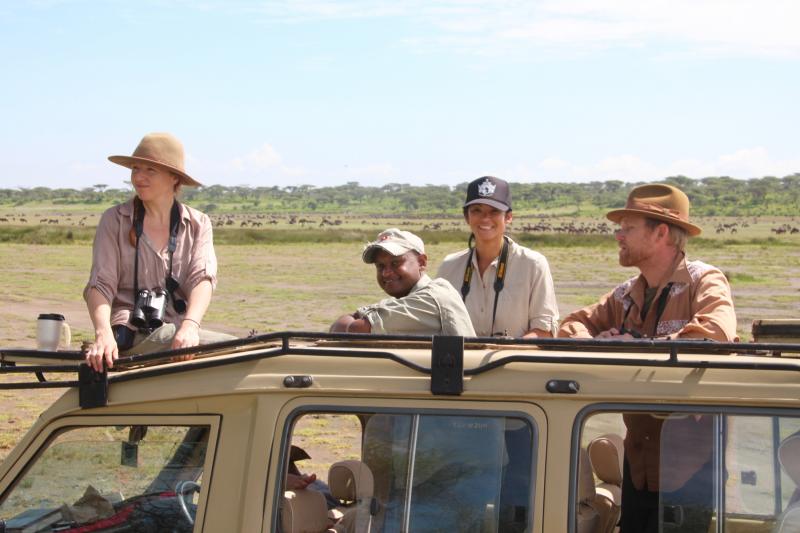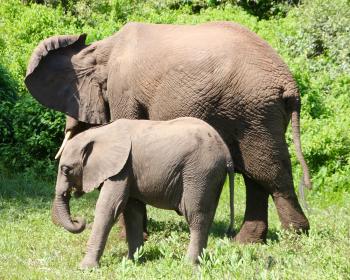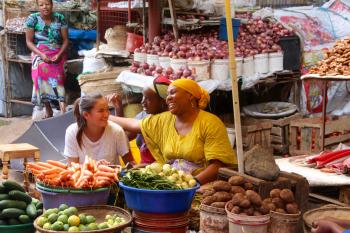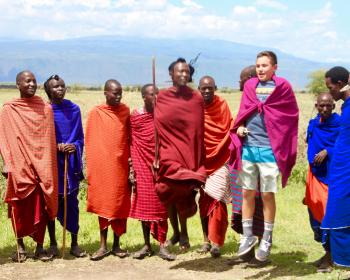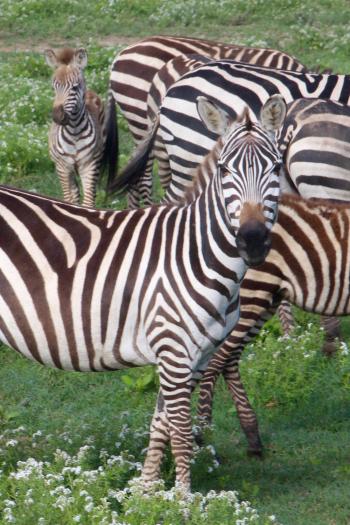Finding fun for all as three generations embark on a Tanzanian safari
This article appears on page 34 of the September 2016 issue.
As a way to celebrate our 50th wedding anniversary, my wife, Rosie, and I wanted to take a family trip that would include our two sons, their wives and our two teenage grandchildren and be in a location away from Southern California. We faced three challenges: finding a time when all were available, deciding on a location and an activity that would appeal to all of us (ranging in age from 13 to 77) and keeping costs to a reasonable amount.
After considerable consultation, we found that the only time slot that fit into everyone’s schedule was one week at Christmastime (Dec. 17-26, 2015).
While we had considered a resort in Hawaii or Mexico, none of us were really resort fans. Rosie and I had been to Tanzania in 2005 on a safari and treasured the experience, hoping that one day we could share a similar adventure with our family. We soon discovered that, similar to that saying in “Field of Dreams,” if we proposed it, they would come.
Making plans
Fortunately, we had stayed in touch with our Tanzanian guide, Shaaban Lagwen, who now operates his own safari business, Fila Adventures (Tanzania; phone +255 787 37 1414, www.filaadventures.com). We trusted his skills as a guide as well as his judgment regarding accommodations and itinerary.
Additionally, he is familiar with American tastes and expectations. Prior to starting his company, he worked as a guide for a company owned by three American brothers who had grown up in Tanzania, so many of his past clients had come from the US. He also has traveled to the US to visit some of his former clients (including us) and his daughter, who is now a US citizen.
Shaaban told us that late December would be a good time to visit, even though there might be some rain. We asked for an estimate for a 5- or 6-day safari, with a day scheduled prior to the safari that would allow for recovery from jet lag.
We requested mid-level hotels and lodges instead of large, resort-style hotels. On our previous safari, we had stayed one night at the Ndutu Safari Lodge in the Ngorongoro Conservation Area and had especially liked it, so we requested that he try to fit that accommodation into our itinerary. He sent us the names of possible lodges in other areas to choose from and a potential itinerary.
Shaaban proposed a 5-day safari preceded by a one-full-day, 2-night stay in Arusha, the main town from which most of the safaris to the well-known Tanzanian game parks originate. After a bit of negotiation, his estimate was approximately $16,000, including pickups and returns to Kilimanjaro International Airport (an hour each way), all of the park entrance fees, transportation in two Land Cruisers, all meals and some tips.
In addition, the combined round-trip airfares to Kilimanjaro Airport for all of us (six from Los Angeles and two from Denver) came to approximately $16,000. Other out-of-pocket expenses included alcoholic beverages; tips for the guide, driver and housekeeping; visa fees, and trip insurance.
Arusha
Shaaban met us upon our arrival at the airport.
Tanzania requires Americans to have visas, which may be purchased from the Tanzanian embassy in the US for $100 each upon arrival (though the embassy’s website states that getting a visa upon arrival is “not guaranteed” and recommends prepurchase).
While mailing the passport to the embassy in Washington, DC, by FedEx obviously increases the cost, we chose that option in order to expedite the Customs process at the airport, as we had been forewarned that there can occasionally be long waits. We ended up having a rather long wait anyway!
Once we got through Customs, Shaaban drove us to the Ilboru Safari Lodge in Arusha. As the van left the main highway and bounced along the deeply rutted road that ran up a hill through an urban village to the lodge, we began to wonder about Shaaban’s choice of accommodation. However, the lodge did not disappoint!
It had more than 30 cottages spread out in a lush, garden-like setting, with a large swimming pool and a restaurant serving breakfast and dinner. You could also arrange services through the lodge, such as massages and day trips in the Arusha area. It was a good place to recover from jet lag and keep activities to a minimum.
The next day, after a late breakfast, the younger three-fourths of the group walked into town (30 to 40 minutes) while Rosie and I took a taxi to meet them for lunch in a café, where we enjoyed a wonderful pumpkin stew. We then strolled through the town and a market, frequently fending off overly eager and persistent vendors.
Following a brief tour of the National Natural History Museum, located in what was called the Boma, a fortification built in 1899 as the German headquarters, we returned to the lodge for a swim, dinner and a meeting with Shaaban to discuss our safari plans.
The safari begins
After our one full day in Arusha, we started out on our safari adventure in two Land Cruisers, which each held four to six passengers and had a pop-up top that allowed us to stand up for better views.
Shaaban’s brother, Geoffrey, and his son, Hussein, assisted with driving and guiding. Hussein had graduated from a college where he studied wildlife management, so he was able to identify and describe many of the animals we saw along the way.
We drove first through Lake Manyara National Park, located approximately 90 minutes northwest of Arusha. As it is a relatively small national park, safari tours frequently pass through the park in a half day on their way to another, larger park.
While it is often given second-string status for safaris, our visit was extraordinary and a wonderful introduction to what we would be seeing throughout our five days.
Within the first few minutes inside the park, we came across a small herd of six or seven elephants, including two youngsters, as they strolled slowly along the side of the road and into the bush. By the end of the afternoon, I had counted over 12 other species of wildlife, including giraffes, warthogs, lions, wildebeests, dik-diks, hyenas, zebras, waterbucks, cheetahs and baboons plus various birds.
I felt a tremendous sense of relief, like a fund-raising planner who sees that all of the invited celebrities have appeared; at least we hadn’t traveled all that way to be disappointed by an animal no-show!
Lodge life
In the late afternoon, after driving on a 2-lane highway above Ngorongoro Crater, we encountered two lions just a few feet above the road as we headed to our next destination, Ndutu Safari Lodge (where Rosie and I had stayed on our previous trip).
Located 150 kilometers from Lake Manyara and 280 kilometers from Arusha in the southern Serengeti ecosystem, the lodge began as a hunting lodge, became a tented camp and today consists of 34 stone cottages.
The now-familiar acacia trees dotted the plains, and all of the cottages and the main lodge faced Lake Ndutu. As no fences surround the lodge, animals can walk through the grounds; it was not unusual to see elephants or giraffes and others strolling not too far away. In the evenings, we heard various noises — howls and growls, munching and hoof-steps — coming from their nocturnal wanderings. (According to the lodge’s website, watch guards are present day and night.)
To our delight, the lodge, with its stone walls and open beams, provided a setting for a group of genets, small, spotted, cat-like animals, that climbed down through the small openings between the walls and the ceiling. Perched on the rafters, they looked down intently at the guests and waited to be fed by the lodge staff.
Also in the lounge area — besides the bar and areas for conversation, playing games and just enjoying the view — there was an oddly placed desktop computer available for use.
In the evenings, outside the lounge, the lodge staff would start a campfire around which guests could also gather.
The restaurant served plentiful and tasty meals and, according to PJ, our granddaughter, had the best pancakes of the trip. When the staff learned that we were celebrating our wedding anniversary, they gathered around us at breakfast and sang an African song to us about long life.
Wonderful wildlife
On our second safari day, our game drive began after breakfast. We drove across verdant fields and into a valley where a pride of lions lounged around a riverbed and small ponds. Parking less than 15 feet from them, we watched the cubs run in and out of the grass and play with their mother as the male snoozed close by next to another pond.
Seemingly disinterested in our presence, two females moved out of the hot sunlight and plopped down in the shade of a neighboring safari vehicle for a siesta. It was like the nature channel in 3-D!
By the middle of the day, I realized that part of the fun and excitement of a safari is discovery — to suddenly come upon a group of baboons or a cheetah or to spot wildlife hidden in the bush or roaming far across the plain. Being able to say “There’s an ostrich!” or “I see a rhino!” became a source of pride and friendly competition.
At midday, Shaaban found an area with picnic tables and restrooms. We ate box lunches containing fried chicken, fruit, yogurt, bread and juice prepared by Ndutu Lodge. This enabled us to continue on the game drive instead of returning to the lodge for lunch.
Some safari tours prefer to return to their respective lodges for lunch and a siesta, resuming the game drive after the midday heat has subsided. In our case, we typically stayed out all day, returning at sunset. And, by the end of the week, we came to realize that not all box lunches are created equal, noticing another tour group enjoying gourmet sandwiches and salads!
Into the Serengeti
In the morning, we left for Serengeti National Park and spent most of the day game-viewing along the way. The previous evening’s rainfall had created a muddy, rutted road, requiring us to occasionally use 4-wheel drive. It was a long day.
As the low-lying sun cast a yellowish tinge on the brown grasslands, we finally arrived at our next accommodation, the Serengeti Kati Kati Tented Camp, located in what seemed like a remote area in the central part of the Serengeti. It was so remote, in fact, that even Shaaban had difficulty finding the correct dirt-road turnoff for it.
The camp had 10 tents — five on each side of the “mess” tent where we ate our meals. The tents, with windows and zipper flaps on each wall, each measured approximately 15 by 20 feet and was covered by a large rain flap. A single solar-powered lamp provided light.
Each tent had separate rooms: a large bedroom with a king-sized bed or twin beds; a bathroom with a flush toilet; a space with a sink and vanity, and a shower.
Taking a shower required that we tell the camp staff when we wanted the wood-fire-heated water brought to the tent and poured into an outside reservoir above the shower room. If we ran out of water before finishing, we could yell “More water!” and the staff person would come with a bucket and replenish the reservoir.
Again, as at Ndutu Lodge, no fences separated the animals from the guests, and the camp management required an employee to accompany guests to their tents at night.
During the evening, we heard the sounds of animals. Our grandchildren, PJ and Colby, shared a tent, and they clearly enjoyed the unsettling noises.
Prior to dinner, the multinational guests (from the Netherlands, France, India and the US) gathered around a large fire ring, having drinks and appetizers, trading stories and/or photos of their day’s sightings or just relaxing.
The camp’s dining facility was in a separate large, open-sided tent, which included a small gift shop besides the eating area. Meals were served buffet-style, and wine and beer were available at reasonable prices.
Until arriving in the Serengeti, we had not seen any leopards. However, on this day’s outing Shaaban spotted one, barely visible, straddling an acacia tree branch with its four legs hanging down. Later, with about 15 other safari groups, we saw another in a tree.
Additional excitement occurred on that day’s drive when one of our Land Cruisers had to stop on the side of a road in order to raise the roof shade, which required the driver to get out of the truck and release a Velcro strap.
At the sound of the Velcro being ripped apart, a muffled roar suddenly emanated from the tall grass about 20 feet from us, and a group of six or seven curious lions popped their heads above the grass. By the time our driver bolted back into the truck, the lions had made their point and were walking warily away.
We returned to our camp for a Christmas Eve dinner in the dining tent, which was decorated with colored lights. The menu featured turkey, beef, chicken and pork along with soup, potatoes, other vegetables, salad and desserts. A few of the groups sang Christmas carols in their respective languages as the moon, full with the color of ivory, hung silently over the acacia trees.
Christmas celebrations
On Christmas Day, on our way to Ngorongoro Crater, we stopped at the Oldupai (Olduvai) Gorge Museum, located in the Great Rift Valley, where Louis and Mary Leakey carried out their research on early humans. It was from there that paleoanthropologists believe some of our earliest human ancestors came.
In a shaded area overlooking the gorge, a staff member gave a brief presentation on the various strata of the canyon and the Leakeys’ finds. The small museum contains fossils collected from the gorge, a photo history of the Leakeys’ work in the area and footprints of three hominids dating back three million years.
From there, we moved on to Ngorongoro Crater, formed millions of years ago by a volcano. Large numbers of animals live on the plains and near the lake on the crater’s floor. As we moved across the crater floor, sitting 2,000 feet below the rim and covering nearly 100 square miles, I was struck by the extraordinary number of different species that were grazing and sharing a common area. Many of them were with their young offspring.
Besides the 4-legged mammals, on this day (and throughout the whole trip) we saw numerous bird species of all sizes, colors and dispositions, ranging from vultures to the tiny, iridescent blue-and-orange starlings hopping along the plain.
During our box lunch picnic on this day, we encountered a flock of black kites flying around the site and noticed that no one was sitting outside of their vehicles. Shaaban suggested that we eat inside, too, since these birds of prey could be aggressive.
We ignored him until one swooped down and grabbed a sandwich from one of our daughters-in-law as she was putting it into her mouth; it scratched her finger in the process. We quickly followed our leader’s suggestion!
We arrived at our final lodging site, the Bougainvillea Safari Lodge, located on the outskirts of Karatu, just as a choir from a local Catholic church began a performance in front of the hotel. They sang songs in Swahili, including some familiar Christmas hymns.
The lodge had 24 cottages (each with a fireplace) set either in the midst of leafy, tropical gardens or around the swimming pool. There was also a restaurant, a bar and a gift shop.
Our Christmas dinner — a generous buffet — included another wonderful stew as well as turkey with gravy, vegetables and numerous desserts.
On to Arusha
After leaving the hotel on our last day, we stopped on our way to Arusha to visit a Maasai boma (small temporary village). Maasai are seminomadic, herding tribes living in the Serengeti region and characterized by their brightly colored (usually red or blue) garments, tall angular body shapes and beaded jewelry. They can frequently be seen standing in a field with their wooden staffs tending cattle or goats.
Tribe members live in small, conically shaped huts, made of mud and straw, arranged in a circle and surrounded by a fence made of thorny tree branches that serve as a corral for their animals and protection from nighttime predators. Settlements close to the main roads often add to their income by being open to tourists.
As we approached the boma, 10 men, joined shortly by a group of women, welcomed us with traditional dances. They placed the colorful garments on us and invited all of us to participate in a traditional jumping dance, which has become a competitive sport.
Feeling compelled to show off my former high school basketball jumping prowess, I joined in… but quickly retired. While our two sons and grandson came close, the vertical leap of one of the Maasai outdid them by at least a foot.
Following a brief introduction to their culture and a visit to one of their huts, the remainder of the experience could be categorized as a “commercial event,” as the hosts directed us to several tables in the middle of the settlement that contained crafts that they hoped to sell.
Our last stop before the airport was in Arusha, where we visited Shaaban’s family in his home. Located on an unpaved road, behind a small storefront operated by his wife and a young man they had “adopted” from the streets, the home belied its interior size and modern décor.
Several members of his family came out to welcome us, including his wife, daughter (visiting her parents with their granddaughter), sister and two or three younger women whom they had also “adopted” in order to assist them in obtaining an education and employment.
Inside, the dining room held a huge spread of food that had been set out for us. The warmth of their hospitality made this intimate interaction a wonderful way to conclude our trip.
After a delicious meal of Tanzanian curry and Indian samosas, we continued on to the airport and an uneventful flight home.
Reflections
Despite the low cost of our trip compared to most safari trips, Shaaban’s judgment and choices did not disappoint. We found the hotels to be comfortable, clean and well maintained, with excellent staff serving flavorsome, healthy and plentiful food. And, of course, Shaaban’s extensive knowledge of wildlife and botany, his keen eye for sighting far-off objects and his affable personality added substantially to the value of this trip.
In retrospect, spending less time seated in the Land Cruisers by returning to the lodge each day for lunch and recreation or a siesta and going back out later in the afternoon seems advisable. An alternative might be to take a midweek break to spend a day at a resort-style hotel around a pool or visit a hunting tribe. However, our time constraints created a desire to see as much as possible in five days and would have made the latter option difficult.
I found sharing this experience with my family and seeing all of them captivated by it — teenagers and adults — to be the most satisfying aspect of the trip.
An initial concern that spending several hours per day on long drives without being connected to social media might pose a problem for our two active and electronically dependent teenagers proved to be unwarranted. The adventure not only provided a learning experience for us, it served as a bonding time for the whole group.
It was a time to escape from the constant bombardment of text messages and cell phone calls (though I will admit to checking my email every evening) and focus on the fantastic array of animal and plant life, to be exposed to a different culture and to just hang out with each other.
As I imagine others have discovered, a safari can be both a highly private and a social experience — spending hours just quietly watching the animals in their habitats in near reverence, interspersed by excitement, laughter and the sharing of stories that will be recalled and repeated as family lore in the years to come. This made it a unique, memorable and worthwhile experience!
If anyone has questions, I can be reached at rsundeen@usc.edu.

